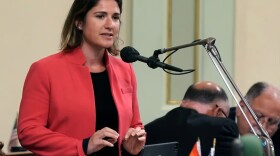U.S. News and World Report released its rankings of the best high schools in the country on Wednesday. These numbers are based on student test scores — U.S. News compared those test scores to state averages as a way of calculating how well a school serves its student body. The rankings also factor in graduation rates and AP and IB exams.
U.S. News awards top schools a medal. According to their analysis, gold-medal schools are "most commonly found in the suburban areas of large cities." But all medal winners — gold, silver, and bronze — are spread across communities, including rural areas, where 37 percent are located.
Black and hispanic students make up less than half of the student population at 78 percent of medal-winning schools. At 61 percent of medal-winning schools, less than half of students receive free or reduced lunch.
BASIS charter schools, a network of schools primarily in Arizona, dominated the top of the lists of both public schools and charters. According to U.S. News, charters and magnets make up about 16 percent of all medal winners — but nearly 41 percent of gold medal schools.
Big demands on single mothers in college
Single mothers in college spend a total of nine hours a day on housework and caring for their children. These moms do more paid work and spend less time in class, on homework and socializing than their peers without children do. That's according to a new analysis by the Institute for Women's Policy Research of data from the American Time Use Survey.
They don't spend as much time caring for themselves — things like sleeping and exercising. All the time spent working and watching kids takes a big toll on the these moms' potential to graduate from college. Fewer than one-third graduate within six years of enrollment.
According to the report, access to on-campus child care can make a big difference in helping parents graduate. Increasing access could take various forms, the report concludes: authors suggest adding funding to child care programs, partnering with outside child care programs and referral services, and funneling some financial aid to parents. This aid could, in turn, help students pay for child care as they work toward their degrees.
Checking in on Starbucks' college program
At Arizona State University graduation this week, 470 Starbucks employees received a degree. The company's Executive Chairman, Howard Schultz, spoke at the graduation. Starbucks reports that 10,000 of its employees — working in 62 percent of its stores — are currently studying for degrees through the university.
In 2014, the company announced it would partner with ASU's highly ranked online program, allowing Starbucks employees to get a partial scholarship, or in some cases, finish their degrees with the public university for free.
The company says that almost 1,300 employees have already graduated through the program, called Starbucks College Achievement Plan. The goal is for 25,000 graduates by 2025. First-generation students make up 20 percent of participants.
Is "value-added" a useful measure of teaching programs?
Last year, almost half of all states ranked teacher preparation programs based on how well graduates performed in the classroom. Many measured teacher effectiveness based on standardized test scores using "value-added" measures — judging the value that these teachers added to their students' academic success. Some, like Louisiana, have been doing it for years.
But this methodology may be flawed, according to an article in EducationNext's summer journal that spells out what two researchers believe to be the pitfalls of judging teachers based on these "value-added" measures.
When states compare teacher prep programs this way, the differences between these programs can seem significant when they're simply random.
But there could be better ways to judge programs. One option? Tracking how many graduates stay in teaching, especially in high-need schools.
Copyright 2018 NPR. To see more, visit http://www.npr.org/.






